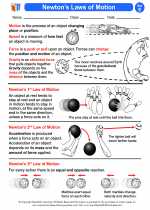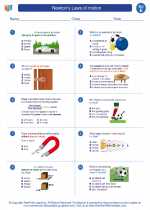Newton's Laws of Motion
Newton's laws of motion are three fundamental principles that describe the behavior of objects in motion. They were formulated by Sir Isaac Newton in the 17th century and are the foundation of classical mechanics.
First Law: Law of Inertia
The first law states that an object at rest will stay at rest, and an object in motion will stay in motion with a constant velocity unless acted upon by an external force. In other words, objects tend to resist changes in their motion.
Study Guide for First Law:
- What is the first law of motion also known as?
Answer: The Law of Inertia
- Define the Law of Inertia.
Answer: An object at rest will stay at rest, and an object in motion will stay in motion with a constant velocity unless acted upon by an external force.
- Provide an example that illustrates the first law of motion.
Answer: A book resting on a table will remain at rest until a force is applied to move it. Similarly, a ball rolling on a smooth surface will continue rolling unless a force stops it.
Second Law: Law of Acceleration
The second law states that the acceleration of an object is directly proportional to the net force acting on it and inversely proportional to its mass. Mathematically, this can be expressed as F = ma, where F is the net force applied to an object, m is the mass of the object, and a is the acceleration produced.
Study Guide for Second Law:
- What is the mathematical equation for the second law of motion?
Answer: F = ma
- Explain the relationship between force, mass, and acceleration according to the second law.
Answer: The acceleration of an object is directly proportional to the net force acting on it and inversely proportional to its mass.
- Calculate the acceleration of a 50 kg object when a force of 100 N is applied to it.
Answer: Using the equation F = ma, we can rearrange it to solve for acceleration: a = F/m. Plugging in the values, we get a = 100 N / 50 kg = 2 m/s^2.
Third Law: Law of Action-Reaction
The third law states that for every action, there is an equal and opposite reaction. When one object exerts a force on a second object, the second object exerts an equal and opposite force on the first object.
Study Guide for Third Law:
- What is the third law of motion also known as?
Answer: The Law of Action-Reaction
- State the law of action-reaction in your own words.
Answer: For every action force, there is an equal and opposite reaction force.
- Provide an example that illustrates the third law of motion.
Answer: When you push against a wall, the force you exert on the wall is matched by an equal force from the wall pushing back on you.
Understanding Newton's laws of motion is crucial in comprehending the behavior of objects in our everyday lives, from the motion of vehicles to the flight of a basketball. Mastery of these laws provides a solid foundation for further exploration in the field of physics.
.◂Science Worksheets and Study Guides Fifth Grade. Newton's Laws of motion

 Activity Lesson
Activity Lesson
 Worksheet/Answer key
Worksheet/Answer key
 Worksheet/Answer key
Worksheet/Answer key
 Worksheet/Answer key
Worksheet/Answer key
 Worksheet/Answer key
Worksheet/Answer key
 Vocabulary/Answer key
Vocabulary/Answer key
 Vocabulary/Answer key
Vocabulary/Answer key
